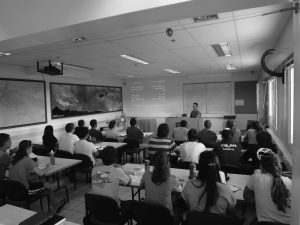Anthony Beers- Staff Writer
Every college student at Oneonta has had a class that consists predominately of note-taking from PowerPoint presentations with multiple choice testing. The student’s major doesn’t tend to matter. This is how most general education classes are run. Since students learn differently, this class format results in a lot of mixed opinions.
Oneonta student Taylor Hoysradt explains that, “When it comes to classes that are mostly note taking and multiple choice tests, it’s easier to do well as far as grading is concerned. But if I actually want to learn something, I prefer classes with much more hands on work.” When grades are involved, the conflict of challenging students can be difficult if teachers want to provide good results for their classes at the end of the semester.
“It also depends on what class you’re taking,” Oneonta student Tom Faraone explained. “If you’re taking something like a music business class, hands on practice is very important so the experiences stick with the student. But if a professor is teaching a class like the History of Aztec Culture, it’s hard to imagine an alternative other than PowerPoint.”
There is an awkwardness in student and teacher relationships in that one is more dependent on the other. Both sides need to do well in order to benefit. The temptation of a teacher to keep the class relatively simple to attain beneficial class results is obviously going to be present. But considering the cost of tuition, are students really getting what they pay for?
Like any class, it depends on the teacher. Some professors are just fine without changing the curriculum for fifteen plus years. Others embrace current events in their lessons and repeatedly challenge students to be creative and do the best they can. But even for those truly great professors that encourage class interaction and actually care about the well-being of the students, it’s difficult to challenge students as much as they would like.
Every first day of class is usually the same for most Oneonta students. It has even been coined “Syllabus Day,” when students receive outlines of what they’re going to be doing for the entirety of the semester. The average student does not get excited over this day because they are simply going to class to receive a piece of paper. But most students do not realize the significance of a syllabus. It is a binding document that teachers are legally obligated to create and it, in essence, limits the creativity of the class. If a teacher has to follow a rubric that he/she makes before even getting to know how the students learn, behave or act, that significantly limits the potential for positive student teacher interaction and the environment of the class suffers.
In all fairness, it is extremely difficult for a teacher to create a positive and creative class environment with limitations like syllabi and students that are only in class to reap the benefits of a good grade. In order to fully maximize college class potential students need to challenge teachers every single day. Students need to utilize the resources they have on campus, such as Milne library and the office hours of teachers to create their ultimate educational experience.
The politics of college classes are complex and sometimes unfair, but at the end of the day it’s truly up to the students to create their best class environment and teacher relationship possible, no matter how many PowerPoints a student must endure.

Leave a Reply